Attitudes Towards Youth Crime and Willingness to Intervene: Findings from the 2006 Scottish Social Attitudes Survey - Research Findings
This study took as its starting point the idea that the problem of youth crime is not simply about the number of ‘things that happen’ but about the way that as individuals and communities we respond to those acts.
The Scottish Social Attitudes ( SSA) survey was launched by the Scottish Centre for Social Research in 1999 and has examined public attitudes towards a wide range of issues in the period since. This report revisits a topic first explored in 2004 - namely, attitudes towards young people and youth crime disorder. In particular, it looks at how adults' willingness to intervene in problematic situations involving young people is shaped by broader contact with and perceptions of young people and youth crime.
Main Findings
- Most people feel they have a reasonable degree of social support and 'connectedness' within their own communities, though women are more likely than men to exhibit higher levels of social connectedness, as are people in higher income households.
- The highest levels of inter-generational contact are found among adults with children aged between 11 and 24. There are significant gaps in contact between the oldest and the youngest age groups, with half of those aged 65 and over saying they know none of the young people in their area.
- Key predictors of a more positive attitude towards young people include higher levels of educational attainment, living in an area of less deprivation and having at least some contact with 16 to 24 year-olds within one's neighbourhood.
- Only 9% of all adults would feel 'very uncomfortable' walking past a group of teenagers or would 'probably avoid doing so altogether', but a further four in ten would feel 'slightly uncomfortable'. Women in general and older women in particular were much more likely to feel very uncomfortable or avoid walking past altogether.
- Levels of inter-generational contact and general social connectedness are the most important predictors of willingness to intervene in a hypothetical situation involving a group of teenagers vandalising a bus shelter.
- Relatively few respondents said they would have 'no concerns' about intervening in such a situation, with a sizeable group inhibited by what they see as the possibility of threatened or actual violence - especially in a scenario involving boys.
- In a situation in which a ten year-old boy/girl was potentially at risk, 36% said they would speak to the child directly while 41% said they would call the police. Men are much less likely to intervene directly in a situation involving a ten year-old girl than boy. For female respondents, the opposite is true.
- Male reluctance to intervene is overwhelmingly associated with concern about wrongful accusations of threat or assault - 64% indicated that they might be reluctant to intervene for this reason in the scenario involving a 10 year-old girl - while female concerns are more likely to relate to anxiety about being threatened or assaulted.
Introduction
This study took as its starting point the idea that the problem of youth crime is not simply about the number of 'things that happen' but about the way that as individuals and communities we respond to those acts. As such, it set out to understand better how the relationship between different age groups might fuel or help to defuse the problem of youth crime.
In particular, the 2006 module was intended to shed light on adult willingness to intervene in situations in which young people are either posing a risk or are at risk themselves. By way of background, however, it also explored a number of related themes, including levels of social trust and 'connectedness' and adult views of young people and youth crime.
Trust, connectedness and inter-generational contact
It is reasonable to hypothesise that more effective informal social control might exist within communities where there are higher levels of social cohesion and 'connectedness'. In particular, higher levels of inter-generational contact might be seen as providing a 'bridge' that gives adults the confidence to intervene in problematic situations involving young people.
The survey included a number of background measures of social trust, social connectedness and inter-generational contact. The results suggest that most people feel they have a reasonable degree of social support and 'connectedness' within their own communities. For example, 84% agreed that 'I have friends of relatives in this area I feel I could turn to for advice or support'. However, this may be based on relatively few, strong relationships with friends and families rather than wider social contact - only 28% agreed strongly that 'I regularly stop and speak to people in my area'.
As Figure 1 shows, general measures of social connectedness are associated with higher levels of inter-generational contact.
Figure 1 - Contact with 11 to 15 year-olds in area by 'social connectedness' scale (%)
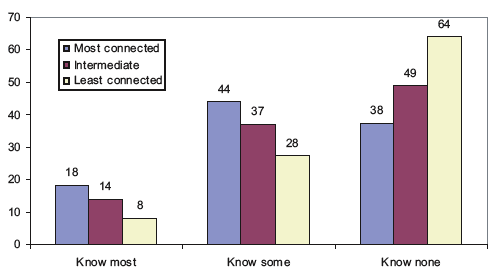
Women are more likely than men to exhibit higher levels of social connectedness, as are people in higher income households. Older people do not appear to be especially disconnected, scoring higher than other age groups on some measures and lower on others.
Older people do score more highly than any other age group in relation to the survey's measure of social trust - for example, 65% of men aged 65 or over agreed that 'most people can be trusted' compared with 54% of men in general. Social trust is also markedly higher among more affluent households. For example, 61% of those in the least deprived areas agreed that 'most people can be trusted' compared with just 37% in the areas of greatest deprivation.
Levels of inter-generational contact tend to vary according to lifestage, rather than age per se, with the highest levels of contact associated with those most likely to have children aged between 11 and 24. Meanwhile, over half of those aged 65 and over (54%) say they know 'none' of the 11 to 15 year-olds in their area, while a similar proportion (51%) know none of those aged 16 to 24.
There is an almost complete absence within the sample of households spanning more than two generations, but a sizeable minority of the 65 plus age group do have links through grandchildren of that age. Although around three adults in ten say that they come into contact with young people simply by meeting them in their neighbourhood, for most adults, inter-generational contact is structured around family ties of various kinds.
Views of young people and youth crime
It was argued in the conclusion to the report on the 2004 module that public attitudes towards young people and youth crime should be seen as not simply reflecting but helping to constitute the problem of 'youth crime'. With that in mind, the 2006 module revisited a number of measures of public attitudes in this area.
General attitudes towards young people appear largely unchanged since 2004 and remain characterised by a tension between sympathy for and concern about 'young people today'. For example, while 62% disagree that the behaviour of young people is no worse than in the past and 45% agree that young people today have no respect for older people, more than half also agree that most people are helpful and friendly and a similar proportion that most are responsible and well-behaved.
Key predictors of a more positive attitude towards young people include higher levels of educational attainment, living in an area of less deprivation and having at least some contact with 16 to 24 year-olds within one's neighbourhood.
Intriguingly, the most negative attitudes towards 'young people today' were expressed by the youngest age group covered by the survey - those who were themselves aged 18-24 at time of interview. Those aged 55 and over, by contrast, tended to hold much more positive views.
Between a fifth and a half of those interviewed thought that the five youth crime-related problems asked about were either very or fairly common in their own neighbourhood, but there was wide variation in overall perceptions of prevalence across sub-groups. One of the most powerful predictors of seeing youth crime problems as common was area deprivation, with those in the most deprived areas much more likely to do so, as Figure 2 shows.
Figure 2 - Perceptions of prevalence of youth crime by area deprivation (%)
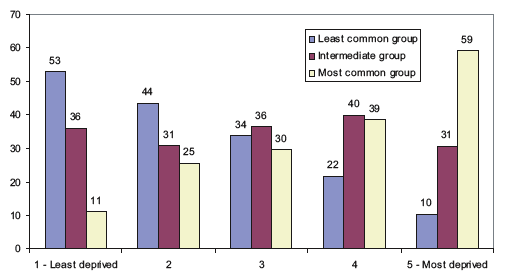
Other variables independently associated with perceiving youth crime as common included lack of contact with 16 to 24 year-olds in the neighbourhood, living in social rented housing, being directly affected by youth crime and having less positive views of young people in general.
A measure of the extent to which individuals have been directly affected by the various types of youth crime-related behaviour suggests a slightly less dramatic picture of the 'problem of youth crime'. Although very clearly related to perceived prevalence, for each type of behaviour, as Figure 3 shows, the proportion indicating they had been affected a 'great deal' or 'quite a lot' was very much lower than those saying the problem was 'very' or 'fairly common' in their area.
Figure 3 - Perceived prevalence versus direct effects of youth crime-related problems (%)
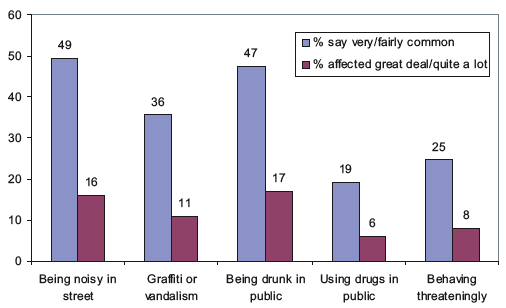
Avoidance behaviour and willingness to intervene
When asked to consider a scenario in which they had to walk past a group of teenagers to get to a shop, only a small proportion of adults (9%) indicated that they would feel 'very uncomfortable' or would 'probably avoid doing so altogether'. But the fact that a further 42% would feel 'slightly uncomfortable' is an indicator of the diffuse sense of unease that groups of young people can produce in adult members of the population. Moreover, the proportion saying they would feel very uncomfortable or avoid walking past altogether is significantly higher among women in general and older women in particular ( e.g. 17% among women aged 65 and over).
In relation to a hypothetical scenario in which a group of male or female teenagers was vandalising a bus shelter, more people said they would be 'very likely' to call the police (31%) than to take any other course of action, but sizeable numbers indicated that they would be likely to take some form of informal action, such as challenging the young people directly (25%), speaking to them later (12%) or speaking to their parents (20%).
Men were more likely than women to say they would challenge the young people directly at the time (especially in the version of the scenario involving boys), but were no more or less likely to take the other courses of action. Otherwise, levels of inter-generational contact and general social connectedness were the most important predictors of willingness to intervene in this situation.
Figure 4 - 'Very likely' to challenge directly by level of contact with 11 to 15 year-olds in area (%)
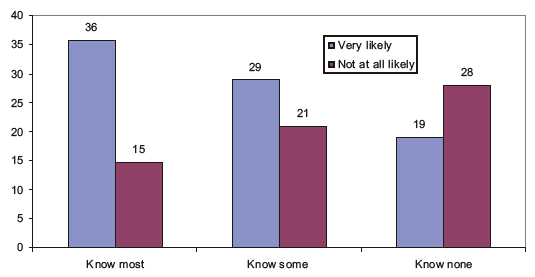
Relatively few respondents said they would have 'no concerns' about intervening in such a situation, with a sizeable group inhibited by what they see as the possibility of threatened (32%) or actual violence (30%). Both male and female respondents are more likely to worry about violence in the scenario involving a group of 14 year-old boys than the one involving girls, but for male respondents, concern about wrongful allegations directed against them is the predominant concern.
When asked to consider a situation in which a ten year-old boy/girl was potentially at risk, around a third of all respondents (36%) said they would speak to the child directly while slightly more said they would call the police.
Figure 5 - Most likely action in scenario involving 10 year-old boy/girl (%)
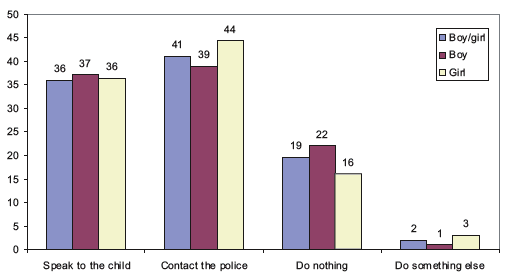
But the interaction of the gender of the respondent with that of the child is critical here. Male respondents are much less likely to intervene directly in a situation involving a ten year-old girl than boy (17% compared with 30%). For female respondents, the opposite is true (43% compared with 52%).
Male reluctance to intervene is overwhelmingly associated with concern about wrongful accusations of threat or assault - indeed, as many as 64% of men indicated that they might be reluctant to intervene for this reason in the scenario involving a 10 year-old girl - while female reticence is relatively more likely to be associated with concern about being threatened or assaulted.
Conclusions
The study suggests there are strong connections between levels of general social connectedness, intergenerational contact, perceptions of young people and youth crime and willingness to intervene. A concomitant of this is that, by focusing on any one of these areas, policy may have intended or unintended consequences for the others.
In general, the research emphasises the need to understand better the notion of civilities as well as incivilities - the circumstances in which individuals feel able and motivated to engage in actions that are of wider social benefit. As part of this, we need to be aware of the ways in which prevailing attitudes and policies may inadvertently inhibit such interventions.
The study has thrown up one hugely significant - if largely unanticipated - finding in this respect: that a large proportion of adult males are now deterred from intervening in problematic situations involving young people, not because of fears for their own safety but concern that they themselves will be accused of threatening behaviour or assault. While there are good reasons why communities have become sensitised to 'stranger danger', we need to be aware of the consequences of this distancing - both for adult males, who would traditionally have played a key role in exercising informal social control in all communities, and for the police and other formal agencies that will increasingly be called upon to fill the gap.
Although effective informal social control is by no means a cure-all for the problems of youth crime, it is probably a necessary - if not sufficient - condition for effective policing. By strengthening social cohesion and connectedness, such interventions can help to create the conditions in which the public will co-operate with the police while also limiting the demands placed on the police in relation to relatively trivial problems.
Looking forward, it is clear that demographic change is likely to limit further the opportunities for intergenerational contact and, consequently, to have important consequences for the construction of the 'problem of youth crime' in Scotland's communities. In policy terms, there is a case both for anticipating the consequences of such developments and considering what steps might be taken to prepare for them - e.g. by seeking to promote or reinforce opportunities for intergenerational contact.
As ever, the biggest challenges in this respect lie in the most deprived communities, the areas of greatest need and fewest resources, which also suffer from the most serious crime-related problems. Do high levels of youth crime reduce the capacity to exert such control, or does the lack of informal control lead to youth crime? The answer is almost certainly both, which again emphasises the need for policy to pay as much attention to reactions as actions, to civilities as incivilities, and to pro-social as anti-social behaviour.
Methodology
The Scottish Social Attitudes survey involves c. 1,500 interviews annually, with respondents selected using random probability sampling to ensure that the results are robust and representative of the Scottish population. The 2006 survey, which was conducted between August 2006 and early January 2007, involved face-to-face interviews and a self-completion questionnaire.
If you have any enquiries about Education Services research findings please contact
Dissemination OfficerThe Scottish Government
Education, Information and Analytical Services
1 B South
Victoria Quay
Edinburgh
EH6 6QQ
Tel: 0131 244 0894
Fax: 0131 244 5581
Email recs.admin@scotland.gsi.gov.uk
Website: www.scotland.gov.uk/socialresearch
Online copies
The research Findings is web only and can be downloaded from the publications section of The Scottish Government website: www.scotland.gov.uk
This document (and other Research Findings and Reports) and information about social research in the Scottish Government may be viewed on the Internet at: http://www.scotland.gov.uk/socialresearch
The site carries up-to-date information about social and policy research commissioned and published on behalf of the Scottish Government. Subjects covered include transport, housing, social inclusion, rural affairs, children and young people, education, social work, community care, local government, civil justice, crime and criminal justice, regeneration, planning and womens issues. The site also allows access to information about the Scottish Household Survey.
There is a problem
Thanks for your feedback